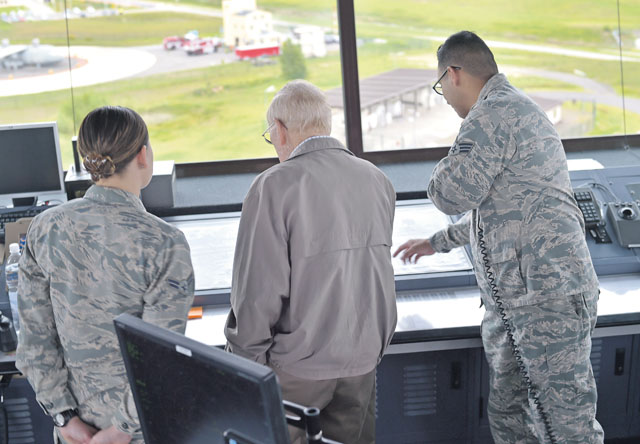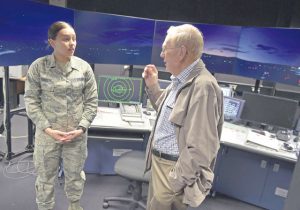
It doesn’t happen often, and it won’t happen for some. But occasionally, Airmen get the opportunity to meet an original 1947-era Airman — those trailblazers who laid the first bricks of airpower on the long blue line.
Retired Chief Master Sgt. Kenneth Andrews, who served at Ramstein from 1959 to 1962, started his 30-year Air Force career in 1947. He recently took advantage of the opportunity to come back to Europe to visit family and a familiar sight — the air traffic control tower.
“What an eye opener this has been to see what’s happened in the last 50 years,” Andrews said. “If someone were to blindfold me and set me down here, I would not recognize this place as Ramstein. It’s changed that much.”
In his 30 years of being an Airman and air traffic controller, Andrews had the opportunity to serve in several combat roles, including Vietnam. His stories were told as if they happened yesterday. The details were that clear to him.
“Vietnam was a different situation. We would have maybe 50 airplanes taxiing out for departure and coming in at one time,” Andrews said. “As one aircraft was taking off the other was taxiing right behind it.
“Every morning it looked like the whole airport was headed out to the runway,” Andrews continued. “I would go into meetings and tell them we were violating every rule in the book. … It was the only way to make the operation work and have that many airplanes out there.”
Andrews and his grandson, Lt. Col. Michael Andrews, were shown the tower and introduced to other controllers by Airman 1st Class Paige Goulette. Goulette was testing for her air traffic control 5-level upgrade training that day. She stuck close to the side of the retired chief, hanging on to every word of every story he told during his visit.
“When we were briefed (Andrews) worked here from ’59 to ’62, we were all so excited up here in the tower. I think it’s extremely humbling to listen to someone talk about the area you work and the way things were more than 50 years ago,” Goulette said. “I think the moment he told us he was here when the Berlin Wall was being built really made us realize how different the world was back when he was controlling traffic.”

The equipment Andrews was working with as a controller was far different from the equipment being used today. The stories he shared with Goulette and others showed just how far avionics and other advances in the air traffic controlling realm have come.
“After hearing the equipment he worked with, it really made us take a step back,” Goulette said. “I don’t ever think we can understand how hard this job was when he worked as a controller, but we can try to imagine. And we all have the utmost respect for him and all that he’s done.”
As Andrews departed the tower, he shook every tower controller’s hand and thanked them for all they continue to do for the Air Force.
“I would do it all over again tomorrow,” Andrews said as he made his way towards the door.


